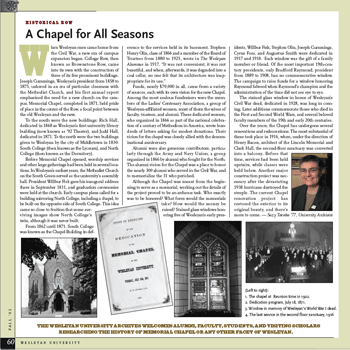HISTORICAL ROW: A CHAPEL FOR ALL SEASONS
 When Wesleyan men came home from the Civil War, a new era of campus expansion began. College Row, then known as Brownstone Row, came into its own with the construction of three of its five prominent buildings. Joseph Cummings, Wesleyan’s president from 1858 to 1875, ushered in an era of particular closeness with the Methodist Church, and his first annual report emphasized the need for a new church on the campus. Memorial Chapel, completed in 1871, held pride of place in the center of the Row, a focal point between the old Wesleyan and the new.
When Wesleyan men came home from the Civil War, a new era of campus expansion began. College Row, then known as Brownstone Row, came into its own with the construction of three of its five prominent buildings. Joseph Cummings, Wesleyan’s president from 1858 to 1875, ushered in an era of particular closeness with the Methodist Church, and his first annual report emphasized the need for a new church on the campus. Memorial Chapel, completed in 1871, held pride of place in the center of the Row, a focal point between the old Wesleyan and the new.
To the south were the new buildings: Rich Hall, dedicated in 1868 as Wesleyan’s first university library building (now known as ’92 Theater), and Judd Hall, dedicated in 1871. To the north were the two buildings given to Wesleyan by the city of Middletown in 1830: South College (then known as the Lyceum), and North College (then known as the Dormitory).
Before Memorial Chapel opened, worship services and other large gatherings had been held in several locations. In Wesleyan’s earliest years, the Methodist Church on the South Green served as the university’s assembly hall. President Willbur Fisk gave his inaugural address there in September 1831, and graduation ceremonies were held at the church. Early campus plans called for a building mirroring North College, including a chapel, to be built on the opposite side of South College. This idea came so close to fruition that some surviving images show North College’s twin, although it was never built.
From 1862 until 1871, South College was known as the Chapel Building in deference to the services held in its basement. Stephen Henry Olin, class of 1866 and a member of the Board of Trustees from 1880 to 1925, wrote in The Wesleyan Alumnus in 1917, “It was not convenient, it was not beautiful, and when, afterwards, it was degraded into a coal cellar, no one felt that its architecture was inappropriate for its use.”
Funds, nearly $70,000 in all, came from a variety of sources, each with its own vision for the new Chapel. Among the most zealous fundraisers were the members of the Ladies’ Centenary Association, a group of Wesleyan-affiliated women, most of them the wives of faculty, trustees, and alumni. These dedicated women, who organized in 1866 as part of the national celebration of a century of Methodism in America, wrote hundreds of letters asking for modest donations. Their vision for the chapel was closely allied with the denominational anniversary.
Alumni were also generous contributors, particularly through the Army and Navy Union, a group organized in 1866 by alumni who fought for the North. The alumni vision for the Chapel was a place to honor the nearly 300 alumni who served in the Civil War, and to memorialize the 31 who perished.
Although the Chapel was meant from the beginning to serve as a memorial, working out the details of the project proved to be an arduous task. Who exactly was to be honored? What form would the memorials take? How would the money be raised? Stained glass windows honoring five of Wesleyan’s early presidents, Willbur Fisk, Stephen Olin, Joseph Cummings, Cyrus Foss, and Augustus Smith were dedicated in 1917 and 1918. Each window was the gift of a family member or friend. Of the most important 19th-century presidents, only Bradford Raymond, president from 1889 to 1908, has no commemorative window. The campaign to raise funds for a window honoring Raymond faltered when Raymond’s champion and the administration of the time did not see eye to eye.
The stained glass window in honor of Wesleyan’s Civil War dead, dedicated in 1928, was long in coming. Later additions commemorate those who died in the First and Second World Wars, and several beloved faculty members of the 19th and early 20th centuries.
Over the years, the Chapel has undergone several renovations and redecorations. The most substantial of these took place in 1916, when, under the direction of Henry Bacon, architect of the Lincoln Memorial and Clark Hall, the second-floor sanctuary was converted into a balcony. Before that time, services had been held upstairs, while classes were held below. Another major construction project was necessary after the devastating 1938 hurricane destroyed the steeple. The current Chapel renovation project has restored the exterior to its original beauty, and there’s more to come.
Suzy Taraba ’77, University Archivist
